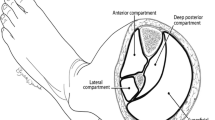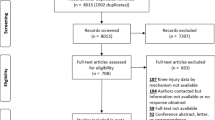Abstract
Ballistic injuries to peripheral nerves are devastating injuries frequently encountered in modern conflicts and civilian trauma centers. Such injuries often produce lifelong morbidity, mainly in the form of function loss and chronic pain. However, their surgical management still poses significant challenges concerning indication, timing, and type of repair, particularly when they are part of high-energy multi-tissue injuries. To help trauma surgeons, this article first presents basic ballistic concepts explaining different types of missile nerve lesions, described using the Sunderland classification, as well as their usual associated injuries. Current controversies regarding their surgical management are then described, including nerve exploration timing and neurolysis’s relevance as a treatment option. Finally, based on anecdotal evidence and a literature review, a standardized management strategy for ballistic nerve injuries is proposed. This article emphasizes the importance of early nerve exploration and provides a detailed method for making a diagnosis in both acute and sub-acute periods. Direct suturing with joint flexion is strongly recommended for sciatic nerve defects and any nerve defect of limited size. Conversely, large defects require conventional nerve grafting, and proximal injuries may require nerve transfers, especially at the brachial plexus level. Additionally, combined or early secondary tendon transfers are helpful in certain injuries. Finally, ideal timing for nerve repair is proposed, based on the defect length, associated injuries, and risk of infection, which correlate intimately to the projectile velocity.

adapted from Giannou and Baldan [23]. Shooting channel of a non-deforming low-velocity bullet shows little yaw and no tumbling: the temporary cavity is long and narrow without significant shock wave effect (upper). The shooting channel of a non-deforming high-velocity bullet typically presents three phases (lower): narrow straight channel (phase 1), large temporary cavity related to the shock wave effect (phase 2), and narrow end channel (phase 3). In this case, the temporary cavitation is due to spontaneous projectile tumbling after a 15 cm straight channel. If this bullet had exited the target before 15 cm, no tumbling and no shock wave effect would have been noticed. Take note that many other parameters can affect these theorical schemes, such as projectile destabilization by external barriers or bones, projectile deformation, and fragmentation







Similar content being viewed by others
References
Stewart MPM, Birch R. Penetrating missile injuries of the brachial plexus. J Bone Joint Surg Br. 2001;83:B517–24.
Bhandari PS, Sadhotra FP, Bhargava P, Bath AS, Mukherjee MK, Singh P, et al. Management of missile injuries of the brachial plexus. IJNT. 2006;3:49–54.
Stoebner AA, Sachanandani NS, Borschel GH. Upper and lower extremity nerve injuries in pediatric missile wounds: a selective approach to management. Pediatr Surg Int. 2011;27:635–41.
Birch R, Eardley WGP, Ramasamy A, Brown K, Shenoy R, Anand P, et al. Nerve injuries sustained during warfare. Part I—Epidemiology. J Bone Joint Surg Br. 2012;94B:523–8.
Birch R, Misra P, Stewart MPM, Eardley WGP, Ramasamy A, Brown K, et al. Nerve injuries sustained during warfare: part II—outcomes. J Bone Joint Surg Br. 2012;94B:529–35.
Chambers JA, Hiles CL, Keene BP. Brachial plexus injury management in military casualties: who, what, when, why, and how. Mil Med. 2014;179:640–4.
Rivera JC, Glebus GP, Cho MS. Disability following combat-sustained nerve injury of the upper limb. Bone Joint J. 2014;96B:254–8.
Rochkind S, Strauss I, Shlitner Z, Alon M, Reider E, Graif M. Clinical aspects of ballistic peripheral nerve injury: shrapnel versus gunshot. Acta Neurochir (Wien). 2014;156:1567–75.
Pannell WC, Heckmann N, Alluri RK, Sivasundaram L, Stevanovic M, Ghiassi A. Predictors of nerve injury after gunshot wounds to the upper extremity. Hand. 2017;12:501–6.
Masmejean E, Bihel T, Lafosse T, Pierrart J, Silvera J, Mir O, Gregory TM. Bataclan’s ulnar nerve syndrome. Am J Med. 2017;130:e105–6.
Rasulić L, Simić V, Savić A, Lepić M, Kovačević V, Puzović V, et al. Management of brachial plexus missile injuries. Acta Clin Croat. 2018;57(3):487–96.
Jones PE, Meyer M, Faillace WJ, Landau ME, Smith JK, McKay PL, et al. Combat injury of the sciatic nerve—an institutional experience. Mil Med. 2018;183:e434–41.
El Hadj AY, Beveridge J, Chan M, Deeb T, Mowafi H, Al-Nuaimi S, et al. Devastating neurologic injuries in the Syrian war. Neurol Clin Pract. 2019;9:9–15.
Mathieu L, Alqassab S, Fakhi RM. Sniper-induced sciatic nerve injury. BMJ Mil Health. 2020;166:210.
Iordache SD, Gorski A, Nahas M, Feintuch L, Rahamimov N, Rutenberg TF. Treatment of peripheral nerve injuries in Syria’s war victims: experience from a northern Israeli hospital. Isr Med Assoc J. 2021;23:279–85.
Guedes F, Sanches GE, Novaes N, Guimarães Ferreira A, Torrão F. Surgical management of pediatric patients with peripheral nerve and plexus lesions caused by stray bullets. Childs Nerv Syst. 2021;37:1219–27.
Straszewski AJ, Schultz K, Dickherber JL, Dahm JS, Wolf JM, Strelzow JA. Gunshot-related upper extremity injuries at a level 1 trauma center. J Hand Surg Am. 2021. https://doi.org/10.1016/j.jhsa.2021.03.020.
Wang E, Inaba K, Byerly S, Escamilla D, Cho J, Carey J, et al. Optimal timing for repair of peripheral nerve injuries. J Trauma Acute Care Surg. 2017;83:875–81.
MacKay BJ, Cox CT, Valerio IL, Greenberg JA, Buncke GM, Evans PJ, et al. Evidence-based approach to timing of nerve surgery: a review. Ann Plast Surg. 2021;87:e1-21.
Jandial R, Reichwage B, Levy M, Duenas V, Sturdivan L. Ballistics for the neurosurgeon. Neurosurgery. 2008;62:472–80.
Secer H, Daneyemez M, Tehli O, Gonul E, Izci Y. The clinical, electrophysiological, and surgical characteristics of peripheral nerve injuries caused by gunshot wounds in adults: a 40-year experience. Surg Neurol. 2008;69:143–52.
Mathieu L, Bertani A, Gaillard C, Chaudier P, Ollat D, Bauer B, Rigal S. Surgical management of combat-related upper extremity injuries. Chir Main. 2014;33:174–82.
Giannou C, Baldan M. Mechanisms of injury during armed conflict. In: War surgery: working with limited resources in armed conflict and other situations of violence. Volume 1, 2nd edition. Geneva: ICRC; 2019. pp.55–80.
Sunderland S. A classification of peripheral nerve injuries producing loss of function. Brain. 1951;74:491–516.
Oberlin C, Rantissi M. Gunshot injuries to the nerves. Chir Main. 2011;30:176–82.
Farber SJ, Saheb-Al-Zamani M, Zieske L, Laurido-Soto O, Bery A, Hunter D, et al. Peripheral nerve injury after local anesthetic injection. Anesth Analg. 2013;117:731–9.
Pfister G, de Carbonnières A, Dubourg O, Prat N, Cremades A, Mathieu L. Nerve injuries from gunshot wounds: what are the microscopic lesions on the continuous part of the partial sections? Hand Surg Rehabil. 2018;37:384–5.
Bercik MJ, Kingsbery J, Ilyas AM. Peripheral nerve injuries following gunshot fracture of the humerus. Orthopedics. 2012;35:e349–52.
Akhavan-Sigari R, Mielke D, Farhadi A, Rohde V. Study of radial nerve injury caused by gunshot wounds and explosive injuries among Iraqi soldiers. J Med Sci. 2018;6:1622–6.
Kline DG, Kim D, Midha R, Harsh C, Tiel R. Management and results of sciatic nerve injuries: a 24-year experience. J Neurosurg. 1998;89:13–23.
Korompilias AV, Payatakes AH, Beris AE, Vekris MD, Afendras GD, Soucacos PN. Sciatic and peroneal nerve injuries. Microsurgery. 2006;26:288–96.
Boyd KU, Fox IK. Nerve repair and grafting. In: Mackinnon SE, editor. Nerve surgery. New York: Thieme Medical Publishers; 2015. p. 75–100.
Samardzić MM, Rasulić LG, Vucković CD. Missile injuries of the sciatic nerve. Injury. 1999;30:15–20.
Kim DH, Murovic JA, Tiel R, Kline DG. Management and outcomes in 353 surgically treated sciatic nerve lesions. J Neurosurg. 2004;101:8–17.
Nulsen FE, Slade WW. Recovery following injury to the brachial plexus. In: Woodhal BG, ed. Peripheral nerve regeneration. A follow-up study of 3656 World War II injuries. Washington, DC: Government Printing Office; 1956:389–408.
Gousheh J, Arasteh E, Beikpour H. Therapeutic results of sciatic nerve repair in Iran-Iraq War casualties. Plast Reconstruct Surg. 2008;121:878–86.
Saito H, Dahlin LB. Expression of ATF3 and axonal outgrowth are impaired after delayed nerve repair. BMC Neurosci. 2008. https://doi.org/10.1186/1471-2202-9-88.
Jonsson S, Wiberg R, McGrath A, Novikov LN, Wiberg M, Novikova LN, et al. Effect of delayed peripheral nerve repair on nerve regeneration, Schwann cell function and target muscle recovery. PLoS ONE. 2013;8:e56584.
Pan D, Mackinnon SE, Wood MD. Advances in the repair of segmental nerve injuries and trends in reconstruction. Muscle Nerve. 2020;61:726–39.
Samadian M, Rezaee O, Haddadian K, Sharifi G, Abtahi H, Hamidian M, et al. Gunshot injuries to the brachial plexus during wartime. Br J Neurosurg. 2009;23:165–9.
Ferrante MA, Wiboum AJ. The electrodiagnostic examination with peripheral nerve injuries. In: SE Mackinnon eds. Nerve surgery. New York: Thieme Medical Publishers, Inc. New York. 2015; p.59–74.
Holzgrefe RE, Wagner ER, Singer AD, Daly CA. Imaging of the peripheral nerve: concepts and future direction of magnetic resonance neurography and ultrasound. J Hand Surg Am. 2019;44:1066–79.
Smith JK, Miller ME, Carroll CG, Faillace WJ, Nesti LJ, Cawley CM, et al. High-resolution ultrasound in combat-related peripheral nerve injuries. Muscle Nerve. 2016;54:1139–44.
Nwawka OK, Casaletto E, Wolfe SW, Feinberg JH. Ultrasound imaging of brachial plexus trauma in gunshot injury. Muscle Nerve. 2019;59:707–11.
Roganovic Z. Missile-caused median nerve injuries: results of 81 repairs. Surg Neurol. 2005;63:410–8.
Mathieu L, Pfister G, Murison JC, Oberlin C, Belkheyar Z. Missile injury of the sciatic nerve: observational study supporting early exploration and direct suture with flexed knee. Mil Med. 2019;184:e937–44.
Mathieu L, Addas BMJ, Irimura SC, Oberlin C, Belkheyar Z. Management of sciatic nerve defects: lessons learned and proposal for a new strategy. Ann Plast Surg. 2020;84:559–64.
Bourrel P, De Bisschop G. Suture of the sciatic nerve performed 15 months after its section. Result 2 years later. Value of repeated exploration. Ann Chir. 1966;20:1145–9.
Pfister G, Ghabi A, de Carbonnières A, Oberlin C, Belkheyar Z, Mathieu L. Direct suturing of sciatic nerve defects in high-degree knee flexion: an experimental study. World Neurosurg. 2020;133:e288–92.
Dunn JC, Tadlock J, Klahs KJ, Narimissaei D, McKay P, Nesti LJ. Nerve reconstruction using processed nerve allograft in the U.S. Military. Mil Med. 2021;186:e543–8.
Roganovic Z. Missile-caused ulnar nerve injuries: outcomes of 128 repairs. Neurosurgery. 2004;55:1120–9.
Kitta MI, Ariandi M, Nugroho YA, Nur A, Arden F. Neurological recovery across a 2-cm gap of radial nerve using end to end suture following supracondylar humerus fracture: case report. Int J Surg Case Rep. 2021. https://doi.org/10.1016/j.ijscr.2021.105896.
Rebowe R, Rogers A, Yang X, Kundu SC, Smith TL, Li Z. Nerve repair with nerve conduits: problems, solutions, and future directions. J Hand Microsurg. 2018;10:61–5.
Ducic I, Barrett DM, Al-Attar A. Benign peripheral nerve tumors: treatment algorithm and reconstructive options. Ann Plast Surg. 2009;63:156–61.
Bhandari PS, Deb P. Management of isolated musculocutaneous injury: comparing double fascicular nerve transfer with conventional nerve grafting. J Hand Surg Am. 2015;40:2003–6.
Brown JM, Yee A, Mackinnon SE. Distal median to ulnar nerve transfers to restore ulnar motor and sensory function within the hand: technical nuances. Neurosurgery. 2009;65:966–78.
Pages L, Le Hanneur M, Cambon-Binder A, Belkheyar Z. C5/C6 brachial plexus palsy reconstruction using nerve surgery: long-term functional. Orthop Traumatol Surg Res. 2020;106:1095–100.
Ucak M. Surgical restoration of drop-hand syndrome with tendon transfer in patients injured in the Syrian civil war. Mil Med Res. 2019;6:35.
Mathieu L, Achour S, Oberlin C, Belkheyar Z. Single versus double tendon transfer for foot drop due to post-traumatic common fibular nerve palsy. Eur J Trauma Emerg Surg. 2021. https://doi.org/10.1007/s00068-021-01602-6.
Vayvada H, Demirdöver C, Menderes A, Yilmaz M, Karaca C. The functional results of acute nerve grafting in traumatic sciatic nerve injuries. Ulus Travma Acil Cerrahi Derg. 2013;19:109–14.
Funding
No source of funding.
Author information
Authors and Affiliations
Corresponding author
Ethics declarations
Conflict of interest
The authors declare that they have no conflict of interest.
Rights and permissions
About this article
Cite this article
Mathieu, L., Goncalves, M., Murison, J.C. et al. Ballistic peripheral nerve injuries: basic concepts, controversies, and proposal for a management strategy. Eur J Trauma Emerg Surg 48, 3529–3539 (2022). https://doi.org/10.1007/s00068-022-01929-8
Received:
Accepted:
Published:
Issue Date:
DOI: https://doi.org/10.1007/s00068-022-01929-8




